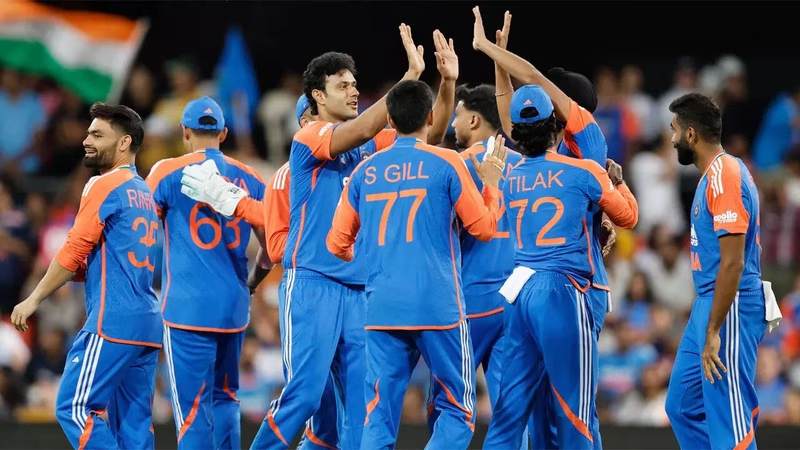Shivam Dube Reveals India’s Bowling Strategy vs Australia: ‘We Planned It Smartly’
India’s commanding 48-run victory over Australia in the fourth T20I wasn’t just about talent—it was about tactics. And according to all-rounder Shivam Dube, every ball bowled was part of a deliberate, well-rehearsed plan. In a candid post-match interview, Dube lifted the curtain on India’s bowling strategy vs Australia, revealing how the team used pitch dimensions, bounce analysis, and role clarity to dismantle one of the world’s most explosive batting line-ups.
Table of Contents
- ‘We Planned It Smartly’: Dube’s Key Revelation
- The Larger Boundaries Tactic That Worked
- How India Prepared for Variable Bounce
- Gautam Gambhir & Support Staff: The Brains Behind the Plan
- Shivam Dube’s Bowling Comeback Story
- Suryakumar Yadav’s On-Field Execution
- Conclusion: Strategy Over Star Power
- Sources
‘We Planned It Smartly’: Dube’s Key Revelation
“We planned it smartly,” Dube said, referring to India’s bowling approach. “The coaching staff worked on specific scenarios during practice, and we stuck to our roles in the match.” This wasn’t reactive cricket—it was proactive, data-informed execution. With Australia needing to chase 168 on a pitch offering variable bounce, India’s bowlers didn’t just attack; they contained.
India’s Bowling Strategy vs Australia: Exploiting Larger Boundaries
One of the most fascinating insights Dube shared was about the stadium’s dimensions. “The square boundaries were larger than usual,” he noted. “So we decided to bowl slightly wide of off-stump and encourage cuts or pulls—shots that would find fielders or fall short of the rope.”
This subtle shift had a massive impact:
- Reduced risk of sixes over square leg or point
- Forced batters into low-percentage shots
- Allowed fielders like Arshdeep Singh and Rinku Singh to patrol the deep effectively
The result? Australia managed just 5 sixes
How India Prepared for Variable Bounce
Dube also highlighted targeted practice sessions focused on handling extra bounce—a critical factor in Indian conditions during this series. “We faced throwdowns with tennis balls on concrete patches to simulate steep bounce,” he explained. “This helped our bowlers hit consistent lengths and our fielders anticipate skied edges.”
This preparation directly contributed to key dismissals:
- Mitchell Marsh’s edge off Dube’s slower ball (caught brilliantly by Arshdeep)
- Glenn Maxwell’s leading edge off Axar Patel
- Tim David’s top-edge off Washington Sundar
Each wicket was a product of plan meeting execution.
Gautam Gambhir & Support Staff: The Brains Behind the Plan
Dube gave special credit to head coach Gautam Gambhir and the bowling coach for instilling confidence—especially in him. “I wasn’t sure about my bowling earlier in the season,” Dube admitted, “but the staff backed me, worked on my variations, and gave me clear roles.”
This reflects a broader shift in Team India’s culture: under Gambhir, every player—even part-timers like Dube—is trained with a specialist mindset. [INTERNAL_LINK:gambhir-coaching-philosophy] The result is a squad where anyone can step up as a sixth bowler without panic.
Shivam Dube’s Bowling Comeback Story
Once seen primarily as a finisher, Dube has quietly evolved into a genuine bowling all-rounder:
- Economy rate in 2025 T20Is: 7.12 (down from 9.30 in 2023)
- Wickets vs Australia: 2 in the 4th T20I, including the crucial wicket of Marsh
- Go-to variation: Slower-ball bouncer, disguised with identical arm speed
His ability to bowl 3–4 overs of tight, wicket-taking spin in the middle overs now makes him indispensable in India’s T20 setup.
Suryakumar Yadav’s On-Field Execution
Captain Suryakumar Yadav played a pivotal role in implementing the strategy. His field placements were aggressive yet smart—using fine leg for bouncers, deep backward square for cuts, and no silly mid-offs to invite false strokes.
More importantly, he trusted his bowlers. When Dube was brought on in the 10th over, SKY gave him back-to-back spells—a sign of complete faith. This synergy between captain, coach, and player is what separates good teams from great ones.
Conclusion: Strategy Over Star Power
India’s win wasn’t built on a single six or a fiery spell—it was built on India’s bowling strategy vs Australia: a blueprint of preparation, adaptability, and collective belief. As Dube’s revelations show, modern cricket is won in the nets and strategy rooms as much as on the field. And with this level of tactical discipline, India isn’t just winning matches—they’re redefining how T20 cricket is played.
